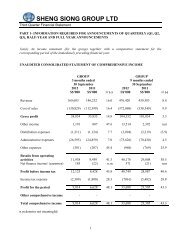FY 2011 Annual Report - Sheng Siong
FY 2011 Annual Report - Sheng Siong
FY 2011 Annual Report - Sheng Siong
You also want an ePaper? Increase the reach of your titles
YUMPU automatically turns print PDFs into web optimized ePapers that Google loves.
50 <strong>Sheng</strong> <strong>Siong</strong> <strong>Annual</strong> <strong>Report</strong> <strong>2011</strong><br />
Notes to the Financial Statements<br />
4 Significant accounting policies (Continued)<br />
4.3 Property, plant and equipment<br />
Recognition and measurement<br />
Property, plant and equipment are stated at cost less accumulated depreciation and impairment losses.<br />
Cost includes expenditure that is directly attributable to the acquisition of the asset. Purchased software that<br />
is integral to the functionality of the related equipment is capitalised as part of that equipment.<br />
When parts of an item of property, plant and equipment have different useful lives, they are accounted for as<br />
separate items (major components) of property, plant and equipment.<br />
Gains and losses on disposal of an item of property, plant and equipment are determined by comparing the<br />
proceeds from disposal with the carrying amount of property, plant and equipment, and are recognised net<br />
within other income in profit or loss.<br />
Subsequent costs<br />
The cost of replacing part of an item of property, plant and equipment is recognised in the carrying amount of<br />
the item if it is probable that the future economic benefits embodied within the part will flow to the Group and<br />
its cost can be measured reliably. The carrying amount of the replaced part is derecognised. The costs of the<br />
day-to-day servicing of property, plant and equipment are recognised in profit or loss as incurred.<br />
Construction-in-progress is stated at cost. No depreciation is charged on construction-in-progress. Upon<br />
completion of the construction-in-progress, the property, plant and equipment are transferred to the respective<br />
property, plant and equipment categories and depreciated accordingly.<br />
Depreciation<br />
Depreciation is calculated over the depreciable amount, which is the cost of an asset, or other amount<br />
substituted for cost, less its residual value.<br />
Except for construction in progress, depreciation is recognised in profit or loss on a straight-line basis over the<br />
estimated useful lives of each part of an item of property, plant and equipment, since this most closely reflects<br />
the expected pattern of consumption of the future economic benefits embodied in the asset. Leased assets<br />
are depreciated over the shorter of the lease term and their useful lives unless it is reasonably certain that the<br />
Group will obtain ownership by the end of the lease term.<br />
The estimated useful lives are as follows:<br />
Leasehold properties – 30 – 80 years<br />
Renovations – 5 years<br />
Plant and machinery – 5 years<br />
Office equipment, furniture and fittings – 5 years<br />
Motor vehicles – 5 years<br />
Computers – 3 years<br />
Cold room – 5 years<br />
Depreciation methods, useful lives and residual values are reviewed at each reporting date and adjusted as<br />
appropriate.



